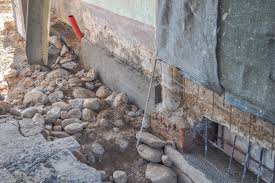Ever watched one of those cooking shows where a chef flips an omelet with a single flick of the wrist? It's impressive, right? Now imagine that same chef reinforcing the underpinning foundation of an ancient house, making sure it stands tall for another century. That's underpinning, the unsung hero of construction.

Underpinning, in the simplest of terms, involves strengthening the foundation of an existing building. But, oh, how intricate this task can be! It’s like keeping a broken plate from shattering by stitching it with the strongest thread. You’d think it’s all about brute force, but don’t be fooled—it’s an art mixed with a hefty dose of science.
Picture this: you’ve got a lovely old home, but the floors have started to slope like a poorly made pancake. What do you do? Call in the underpinning pros. They assess the problem, almost like detectives looking for clues. Their mission is to stabilize and support, ensuring safety and longevity.
Take the tale of Mrs. Thompson's house, a Victorian-era gem that had seen better days. The floors were doing a bit of a Michael Jackson moonwalk, thanks to soil movements underneath. Instead of bulldozing the beauty, underpinning experts came in, evaluated the situation, and deployed the right techniques. Bit by bit, they restored her house, giving it a new lease of life.
Underpinning isn't just about shovels and concrete. Techniques vary—there’s mass concrete, beam and base, mini-piled underpinning, and more. Each method has its flair, like choosing between the delicate brushstrokes of a painter and the chiseling precision of a sculptor. Sometimes, you excavate sections below the foundation, pour concrete, and allow it to cure. Other times, you use beams to spread the load or mini-piles to reach more stable soil layers.
Remember how we said it’s an art and science mix? That’s evident when choosing the correct method. The soil type, structure age, and degree of distress all play a part. If you're thinking it's akin to diagnosing a patient, you're spot on. One wrong move, and you could turn a small hiccup into a full-scale calamity. Yikes!
Moreover, ever experienced an awful neighbor? Well, underpinning projects are like the neighbors you want—they bring real value. Proper underpinning can add to a property’s durability, potentially boosting market value. It’s like turning that awkward, run-down relative into the life of the family party.
On a more whimsical note, underpinning saves not just structures, but also memories. Like Mrs. Thompson’s house, many buildings carry family histories, laughter, tears, and timeless stories within their walls. Preserving them is about more than engineering; it’s keeping those narratives alive for future generations.
But what if the budget’s tight? That’s a conundrum folks often face. It’s similar to trying to fix a leaky pipe with a Band-Aid—cuts some costs now, but you’ll be shelling out more down the road. Striking a balance between immediate expense and long-term benefit is key.
Engaging in underpinning isn’t for the faint-hearted. Imagine trying to play Jenga but with a much, much higher stake. Every piece you shift or secure matters significantly. And the tension? Palpable. Yet, the satisfaction when it's done right? Beyond words. That's probably why these professionals have a gleam in their eye, a quiet confidence in what they do.
In today’s hustle and bustle, where we sometimes overlook lasting stability for quick fixes, underpinning reminds us of the importance of strong foundations. Strong buildings, resilient homes, structures that stand the test of time—it all starts from the ground up. So next time you wander into an old building that feels as solid as a rock, give a nod to underpinning. It’s probably the quiet force that’s holding things together, letting you enjoy the charm of yesteryears in the present day.

